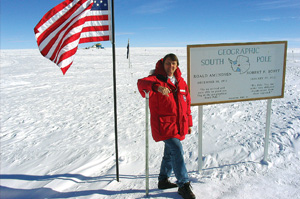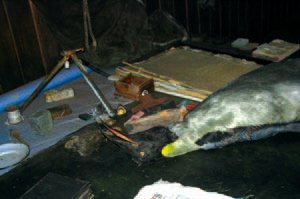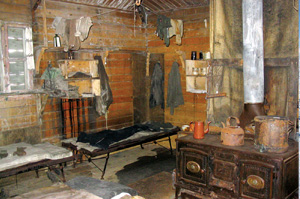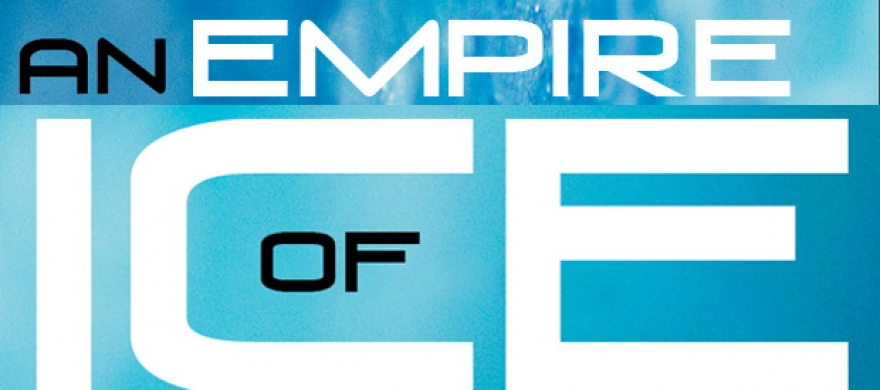An Empire of Ice
On the eve of its publication, Larson shares an excerpt with Pepperdine Magazine.
As a teenager, Edward J. Larson became fascinated with Antarctic exploration while reading Ernest Shackleton’s book South. Since then books on the subject have filled a bookcase in his library and inspired his most recent book,An Empire of Ice: Scott, Shackleton, and the Heroic Age of Antarctic Science.

Larson at the Geographic South Pole
Ten years in the making, Empire of Ice explores the three British Antarctic expeditions of Shackleton and Robert Scott between 1901 and 1913 through a unique lens. “I realized that scientific research conducted by these expeditions was largely forgotten in the focus of historians and the public in the race to the pole,” says Larson, University Professor and Hugh & Hazel Darling Chair in Law at Pepperdine. “I wanted to address this imbalance.”
Informed by extensive trips to the region, collaboration with experts, and participation in the National Science Foundation’s 2003–2004 Antarctic Artists and Writers Program, Larson attempts to place the research work of these three well-known expeditions into a broad scientific, cultural, and social context reaching back into the Victorian era and across to other expeditions of the period. He finds the stories of these research efforts to be as gripping and as meaningful as those involving the dash to the pole.
Roald Amundsen had little interest in reaching anywhere second—or third. He wanted firsts. Publicly, however, he argued the scientific merit of the Arctic drift expedition, assuring backers that it would proceed with or without the pole. He needed to keep up the appearance of a proper scientific expedition to retain his funding, and he stood little chance of gaining support for a South Pole gambit while Robert Scott was preparing a massive expedition to the region.
Confiding at first only in his brother, Leon, and without telling Nansen or the Norwegian government, Amundsen packed Fram for a dash to the South Pole. Ninety-seven sled dogs from Greenland were loaded on board—which made no sense if he could gather huskies in Alaska after the long voyage around the horn—along with a prefabricated hut for wintering on the Ice Barrier. The crew never became suspicious, and the watchful Nansen remained oblivious despite having asked Amundsen “why on earth he’d got so many dogs.” They were not alone: nobody guessed the truth.
Fram’s real destination was revealed only at its last port of call, the remote drift across the Arctic but that finances forced him to detour south. “The masses” demand firsts, Amundsen explained in his letter to Nansen, andf money follows. Because the Norwegian government had refused to provide added funds for the drift expedition once Cook and Peary had claimed the North Pole, he lamented disingenuously, only “this extra excursion” could save “the expedition I originally intended.” By this time, Nansen could not interfere and Scott had already set sail. At his brother’s direction, Leon wired a terse note to Scott in Australia: “Beg leave to inform you Fram proceeding Antarctic.”
Following release of Amundsen’s letter to the public, the press began to trumpet a “great international polar race”—much like the international car races of the period. If this was a race, it was between unequal competitors. Scott’s Terra Nova carried sixty-six men, thirty- four of them in the shore party. They had various missions to perform, only one of which involved reaching the South Pole.
Amundsen’s Fram carried nineteen men, of whom only nine wintered in the Antarctic. All of them focused solely on getting a small party to the pole. Scott set his base on Ross Island, nearly seven hundred miles in a straight line from the pole. But his route called for going around obstacles and up glaciers with heavy sledges. Knowing this in advance, Amundsen established his base, called Framheim, at the Bay of Whales, which was more than sixty miles closer to the goal and, as it turned out, offered a more direct path to it.
After laying depots along their planned routes during their first Antarctic autumn and wintering in their respective bases, the two expeditions set off for the pole late in 1910. Amundsen started twelve days before Scott and traveled faster. “The plan was to leave the station as early in the spring as possible,” the Norwegian explained. “If we had set out to capture this record, we must at any cost get there first.”
The race became increasingly uneven as it progressed. The Norwegians used expertly trained dogs to pull their sledges rapidly across the Ice Barrier, up the mountain passes, and over the Polar Plateau. Those not driving sledges used skis. The British struggled with experimental motorized tractors, white Manchurian ponies, and heavy, man-hauled sledges. Of course, only
Amundsen knew in advance there would even be a race, and unlike Scott, he felt no compulsion to do science along the way. The self-anointed arbiters of Antarctic geography at Britian’s Royal Geographical Society fumed. “What an imposter!" Markham exclaimed to Keltie in December 1910 about Amundsen on learning that the Norwegian was headed south. Although doubting that Amundsen could reach the pole, Markham conceded, “He is still a source of some anxiety.”

The science table from Robert Scott's Terra Nova expedition
“At three in the afternoon a simultaneous, ‘Halt!’ rang out from the drivers,” Amundsen wrote in his account for December 14, 1910. “They had carefully examined their sledge-meters, and they all showed the full distance—our Pole by reckoning. The goal was reached, our journey ended.” The Norwegians saw no sign of Scott. They camped for four days and used every available means to confirm their position.
After repeated observations of the sun, which circled steadily around them for twenty-four hours each day, they determined that the camp was some six miles off the mark and moved their tent accordingly. “On December 17 at noon we had completed our observations, and it is certain that we had done all that could be done. In order if possible to come a few inches nearer to the actual Pole, Hanssen and Bjalland went out four geographical miles (seven kilometers) in the direction of the newly found meridian,” Amundsen wrote. At dinner, they smoked cigars to celebrate.
The news made headlines throughout Europe, North America, and the British Empire, with the supposed race between Amundsen and Scott featuring prominently in the storyline. “The whole world has now been discovered,” the New York Times declared on March 8. Some outside Britain seemed to delight in a small band of Viking raiders tweaking mighty John Bull’s nose.The New York Times, France’sLa Main, and theLondon Daily Chronicle paid Amundsen handsomely for exclusive rights to his first report. Other newspapers tried to scoop them or to run their own cobbled-together accounts, which led to a media frenzy. Celebrations erupted in Norway. At year’s end, the New York Times ranked Amundsen’s polar conquest as the number two news story of 1912, second only to the sinking of theTitanic.
Science now became the only consolation for the British. “If less successful than Amundsen from the standpoint of adventure, Captain Scott and his colleagues promise much ampler scientific material,” the left-leaning English weekly the Nation offered in April. “They have spent their energies in elaborate researches into climate conditions, geological studies, and inquiries into marine biology.” The elite literary journal theAthenaeum added in Scott’s defense, “His expedition had serious scientific objects, so the ‘race for the South Pole,’ imagined by some newspapers, never took place.” Scott, the essayist suggested, was going to the pole in proper British fashion. Markham expressed the general view from the RGS: “There was no question of racing. The grand object was very far from that. It was valuable research in every branch of science. Capt. Amundsen’s plan was different. He conceived of a dash for the South Pole without Capt. Scott’s knowledge.” Similar comments appeared in other British journals. “We offer to Captain Scott and the other members of the British Antarctic expedition the thanks of the scientific world for the attention being given to systematic observations, which are of far greater value than the attainment of the South Pole,” the science journalNature observed on April 4.
Amundsen’s decision to begin a European lecture tour while Scott remained in the field put the RGS in an awkward position. Viewing him as a base record-chaser who had deceived their man, many RGS leaders did not want to honor Amundsen but not doing so might look petty. After all, the society had feted Peary for reaching the North Pole even though he too had done little science and his claim was shrouded in controversy. At least no one doubted that Amundsen reached a pole. RGS President Lord Curzon, an explorer of central Asia who once served as British viceroy of India, announced the invitation in May at an RGS anniversary dinner attended by Prime Minister H. H. Asquith. While praising Scott’s science and questioning Amundsen’s honor, Curzon noted that these concerns “should not deter them from recognizing brave and adventurous achievement wherever accomplished.” A more “hearty and enthusiastic welcome,” he suggested, would await Scott.

Ernest Shackleton's Antarctic hut
The encounter with the RGS was set for November 15. As the date approached, Markham counseled Kathleen Scott not to attend the lecture and wondered aloud how those RGS leaders who did attend could speak to her “after shaking hands with Amundsen.” She returned her priority ticket for the event but slipped quietly into a top gallery. “Amundsen’s speech was plucky and modest but dull, and of a dullness!” she wrote in the diary she still kept for her husband. “He did not mention you except just to say you were at McMurdo Sound.” She noted with evident satisfaction that “there was scarcely anyone on the platform” with Amundsen except Curzon; Charles Darwin’s explorer-son, past RGS president Leonard Darwin; and Scott’s British rival, Shackleton. True to his word, Markham stayed away.
As Kathleen observed, Amundsen gave a modest account that avoided contrasts with Scott. He offered due credit to his sled dogs. Curzon was not so discreet. In introducing Amundsen he spoke more warmly of Scott, “whose footsteps reached the same Pole, doubtless only a few weeks later than Amundsen, and who with unostentatious persistence, and in the true spirit of scientific devotion, is gathering in, during the absence of three years, a harvest of scientific spoils, which when he returns will be found to render his expedition the most notable of modern times.” In his closing remarks following the banquet, Curzon added, “I almost wish that in our tribute of admiration we could include those wonderful good-tempered, fascinating dogs, the true friends of man, without whom Captain Amundsen would never have got to the Pole.” Then, as Amundsen remembered it, Curzon concluded with the phrase, “I therefore propose three cheers for the dogs,” and turned toward the Norwegian.
Amundsen never forgave Curzon’s closing comment, which he considered a “thinly veiled insult.” He lectured throughout Britain with mixed success for another month. When the gate at some of the lectures in England could not cover his fee, Amundsen insisted on full payment even from charities that had organized the lectures to raise funds. “I won’t let these damned English off one single penny,” Amundsen wrote to his brother. “I will not yield a single point to this ‘plum pudding nation.’” Much larger audiences awaited him in continental Europe and the United States.
For their part, the British eagerly awaited a different explorer. “They must look forward to next spring,” Markham told a huge crowd in Dundee, “when the whole country would welcome the return of Captain Scott, the greatest of all Polar explorers, and hear of the geographical achievements of himself and his gallant companions with the deepest interest and with well-founded national pride.” A 1912 British children’s book on polar exploration agreed. “Our own Captain Scott is rapidly approaching the goal,” it assured readers, “and we sincerely trust that, though not first in the race—and, indeed, the obtaining of scientific results, not mere swiftness of march, was his aim—he too may win through.” Early in 1913, the prime minister assured Kathleen Scott that her husband would receive a peerage for his work in Antarctica. The honor only awaited his return. Then Scott, a gifted writer and speaker, would tell a story that would dwarf anything Amundsen could write or say. Drawing on more than a century of British experience in the Antarctic and a dozen years of focused research on Ross Island and Victoria Land, including his two grand expeditions there, he would spin them a tale of science, empire, and adventure at the world’s end.
From An Empire of Ice: Scott, Shackleton, and the Heroic Age of Antarctic Science, by Edward J. Larson, published by Yale University Press. Copyright © 2011 by Edward J. Larson. Excerpted by permission of Yale University Press. All rights reserved.
